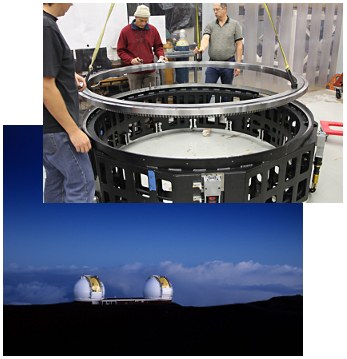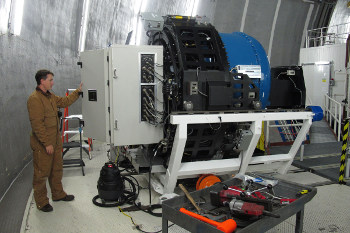 |
| November 06, 2012 | Volume 08 Issue 41 |
Designfax weekly eMagazine
Archives
Partners
Manufacturing Center
Product Spotlight
Modern Applications News
Metalworking Ideas For
Today's Job Shops
Tooling and Production
Strategies for large
metalworking plants
Kaydon mega-bearing helps astronomers study the stars

The Mauna Kea summit, at an elevation of 14,000 ft, provides clear skies for the twin domes of Hawaii's Keck Observatory. Top: Kaydon engineer Wayne TenBrink (r.) installs the bearing with Bob Weber and Hector Rodriquez of Caltech. [Images courtesy: Rick Peterson/W.M. Keck Observatory]
How do you collect data from stars thousands of light years away while positioning a 300-ton telescope to within a fraction of a human hair? You use a high-tech spectrometer called MOSFIRE, rotating on a very large Kaydon bearing.
With MOSFIRE (Multi-Object Spectrometer For Infra-Red Exploration), astronomers can gather spectra at near-infrared wavelengths (invisible to the human eye) and even penetrate cosmic dust clouds to investigate the formation of stars and galaxies. The instrument can survey 46 objects at once and switch targets in minutes, instead of the usual one or two days.
"I reckon that MOSFIRE will observe very faint targets more than a hundred times faster than has ever been possible," says Caltech astronomer Chuck Steidel, MOSFIRE's co-principal investigator. "All the observations my group and I have done in near-infrared spectroscopy with Keck over the last 10 years could be done in just one night with MOSFIRE."
Wow.
MOSFIRE is 25 times more light sensitive than other instruments of its kind and can observe vastly more cosmic objects on any given night. It arrived in February at the W.M. Keck Observatory and had its first light on April 4. The observatory, near the 14,000-ft summit of Mauna Kea on the island of Hawaii, is a scientific partnership of the California Institute of Technology, the University of California, and NASA.

Keck Observatory support astronomer Marc Kassis sets up the MOSFIRE instrument. [Image courtesy: W. M. Keck Observatory]
"Our orientation changes constantly as we track the stars, so the bearing must handle many load combinations, both axial and radial," says Mike Pollard, a Keck engineer. "Astronomers with 20 to 30 years' experience say the Kaydon bearing is the best they've ever seen."
Pollard says that the Kaydon bearing was the only one to meet all the needed project requirements, which included:
- Smooth performance (very little torque variation);
- Mounting to a structure that is slightly compliant (i.e., not stiff);
- Very little wobble -- almost no variation from inner race axis to outer race axis;
- Fit the existing space;
- Harsh environment -- at 14,000 ft, amidst volcanic cinder dust; and
- Very low maintenance.
The custom bearing is hard to categorize, but it is more slewing ring than thin section, according to Kaydon engineer Wayne TenBrink. About 2 m in diameter, it features a back-to-back duplex design with integral gearing. The inner race and outer race are thinner than usual for a slewing ring bearing this size, and each race has two ball paths to spread the load and minimize torque variation.
Since minimizing torque is essential to maintaining the stability needed for reliable data, the Keck Observatory has a lot riding on the Kaydon bearing -- literally. By mating MOSFIRE with the light-gathering power of the 10-m Keck I telescope and the clear skies of Mauna Kea, scientists expect new, exciting discoveries will be made about the universe.
Learn more about Kaydon Bearings Division custom bearings by clicking here. There are some really cool examples, like applications in a baggage scanner and a semiconductor wafer cleaner.
CNET also has a cool article on MOSFIRE that you can read here.
Published November 2012
Rate this article
View our terms of use and privacy policy
